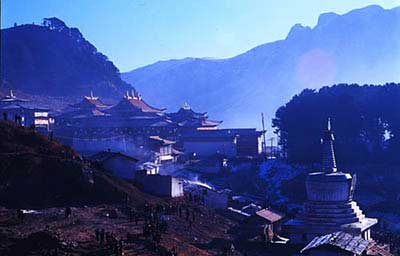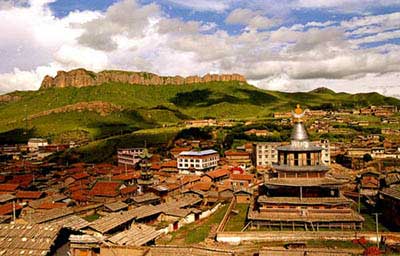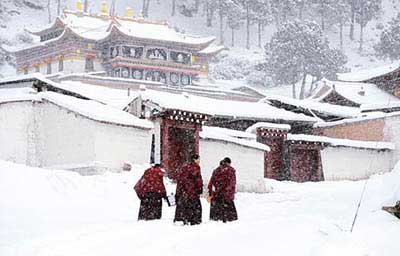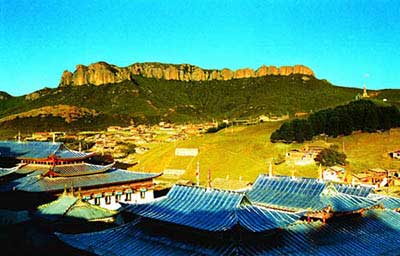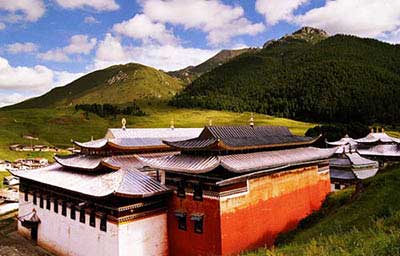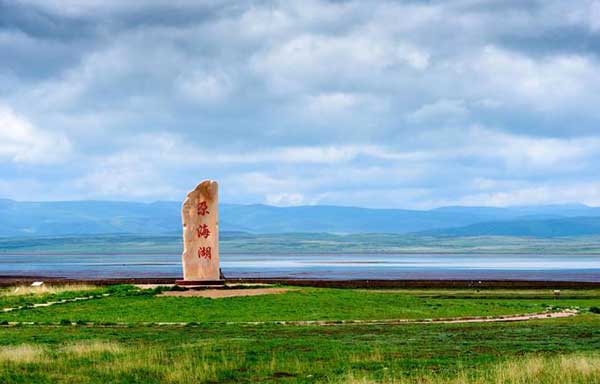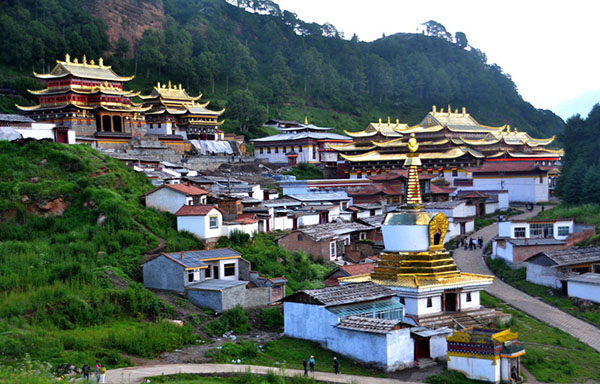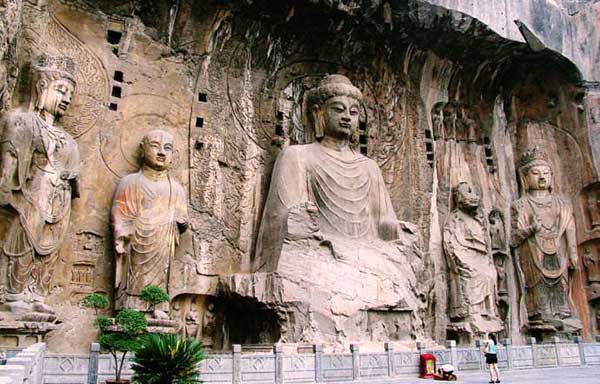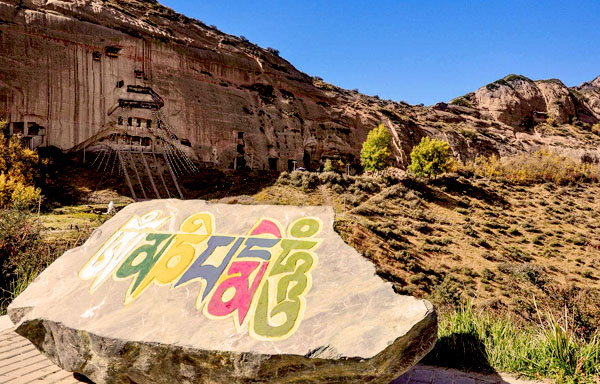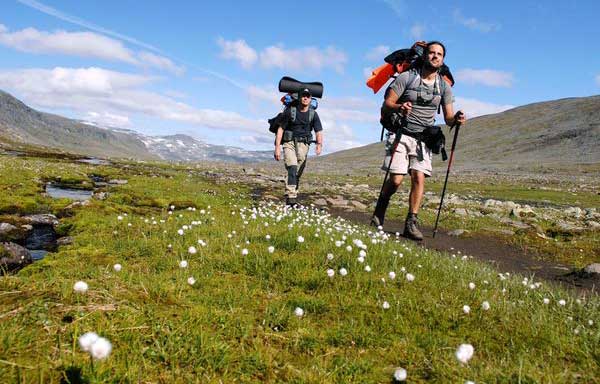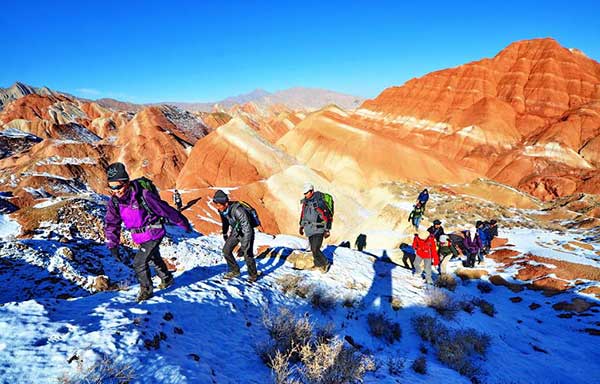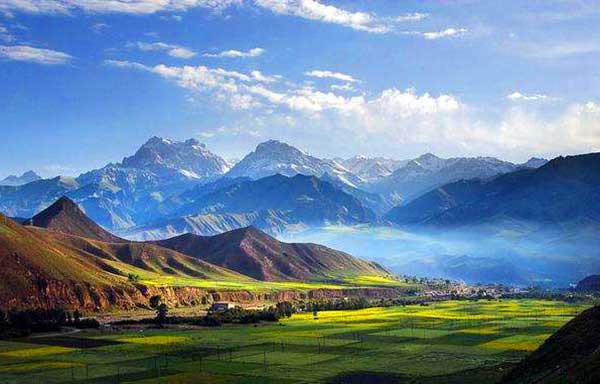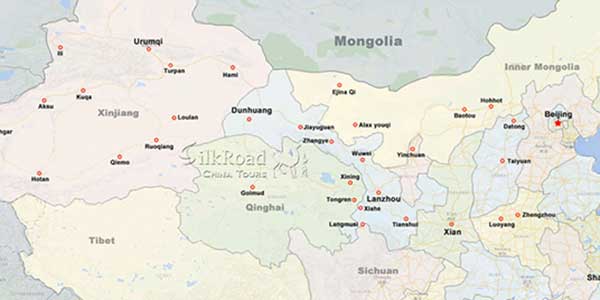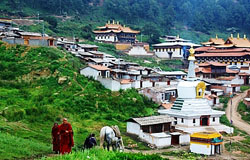 Langmu Monastery is located between Gansu Province and Sichuan Province in Southern Ruoer Gai County. It is not only a name for a monastery, but also a name for a township where Buddhist and Islamic believers live a leisurely life style. A river, Bailong River, separates the township into two parts: one part in Gansu and another one in Sichuan. Langmu monastery is a place where you can experience both Tibetan Buddhism and Islamic culture since there are two Tibetan Buddhist monasteries and one Islamic temple located in Langmu Township. Historically Langmu monastery was the center of local religion, culture, economy and politics. Langmu Monastery’s whole name is “Dacang Lamu Gerdeng Monastery”. In the Tibetan language, Dacang means Tigers’ den. According to legend it got this name because there is a big hole which was called the “tiger’s den” where many tigers lived. Langmu means fairy maiden because many stones in the cave look like pretty girls. So the name “Dacang Langmu” can be translated as "a fairy maiden in the tiger's den".
Langmu Monastery is located between Gansu Province and Sichuan Province in Southern Ruoer Gai County. It is not only a name for a monastery, but also a name for a township where Buddhist and Islamic believers live a leisurely life style. A river, Bailong River, separates the township into two parts: one part in Gansu and another one in Sichuan. Langmu monastery is a place where you can experience both Tibetan Buddhism and Islamic culture since there are two Tibetan Buddhist monasteries and one Islamic temple located in Langmu Township. Historically Langmu monastery was the center of local religion, culture, economy and politics. Langmu Monastery’s whole name is “Dacang Lamu Gerdeng Monastery”. In the Tibetan language, Dacang means Tigers’ den. According to legend it got this name because there is a big hole which was called the “tiger’s den” where many tigers lived. Langmu means fairy maiden because many stones in the cave look like pretty girls. So the name “Dacang Langmu” can be translated as "a fairy maiden in the tiger's den".
The two Tibetan monasteries are very famous Gelu monasteries named Kerti Gompa and Serti Gompa. Kerti Gompa is the biggest and most impressive Gelu Monastery in whole Aba area and belongs to Sichuan province since it is located on Sichuan’s side of the river. In 1413, the first Kerti incarnated lama named Kerti Jiangcan, built a small hermitage in Dacang Langmu. In 1713, the second lineage of Kerti incarnated lama named Tala built a small temple. And later the incarnated lama named Quzong established a small temple again in the same location. The fifth lineage of Kerti the incarnated lama named Dengbi Jiangcan put these three small temples together and expended the monastery in 1748. At present this monastery is composed of five temples, one monastic college and about 650 monks.
Behind the Kerti Monastery there is a gorgeous and sacred gorge. The source of Bailong River is in this beautiful rocky gorge. It is also the location of the famous “Tiger’s den,” as well as the caves of the fairy maidens. In one of the fairy caves there is a natural Tibetan goddess statue called Palden Lhamo. After about 20 or 30 minutes walk through the gorge, you will reach a broad and beautiful grassland.
Serti Gompa belongs to Gansu province and is on the Gansu side of the river. The monastery dates from 1748 AD and is simply referred to as Gansu monastery. This monastery has about 300 monks. To the south of the monastery, about a twenty minute walk, is one of the locations of Tibetan sky burials. If you would like to learn more about how death is handled in Tibetan culture you are welcome to visit this site
Sky Burial
Sky Burial is a funeral practice in which a human corpse is placed on a mountaintop to decompose while exposed to the elements or to be eaten by scavenging animals, especially carrion birds. It is a specific type of the general practice of excarnation. It is practiced in the Chinese provinces and autonomous regions of Tibet, Qinghai, Sichuan and Gansu.
The majority of Tibetan people and many Mongols adhere to Vajrayana Buddhism, which teaches the transmigration of spirits. There is no need to preserve the body, as it is now an empty vessel. Birds may eat it or nature may cause it to decompose. The function of the sky burial is simply to dispose of the remains in as generous a way as possible (the source of the practice's Tibetan name). In much of Tibet and Qinghai, the ground is too hard and rocky to dig a grave, and, due to the scarcity of fuel and timber, sky burials were typically more practical than the traditional Buddhist practice of cremation. In the past, cremation was limited to high lamas and some other dignitaries, but modern technology and difficulties with sky burial have led to an increased use by commoners.
If you walk up past the left side of Serti Monastery, you’ll eventually come to a clearing near a hilltop (ask any local around Serti and he or she can point you in the right direction). The clearing has two boxes of axes and knives, prayer flags, and a pile of ashes. Once the birds are basically done with the main job, the remains are burned. However, not everything makes it into the fire, which means the site is literally littered with skulls, hip bones, and other various bits and pieces.
Gallery
Attractions in the area
Related Tours
General Information
Alias: No
Loc: In Langmusi zhen
Entrance: 30 RMB
Open Time: 8:00-17:00
Relevant blogs
-
How did the name of Tianshui in Gansu come about?
The name Tianshui is very pleasant to the ear, and it reminds one of that exquisitely beautiful verse, "After getting drunk, one doesn't know if the sky is in
-
The 8th Silk Road Hotel Festival was successfully held i
On December 27th, the "8th Silk Road Hotel Festival" grandly opened at the Yujing International Hotel in Zhangye. This hotel festival gathered industry experts,
-
The Karez Irrigation System in Turpan has been selected
On September 3rd, at the 75th Executive Council Meeting of the International Commission on Irrigation and Drainage held in Sydney, Australia, the 2024 (11th bat
-
What is the connection between "dragons" and "snakes
In traditional Chinese culture, the snake has a dual identity of auspiciousness and danger. Ancient people believed that the snake not only possesses divine cha
-
Endangered Przewalski's Horses Spotted at Dunhuang Yume
<p>In early February, a group of special "visitors"—the Przewalski's horses—appeared at the Dunhuang Yumen Pass scenic area in Gansu Province, a U
-
The Fourth Dunhuang Cultural Tourism Supplier Conference
On the morning of February 18th, the Fourth Dunhuang Cultural Tourism Supplier Conference in Northwest China commenced at the Dunhuang International Convention

